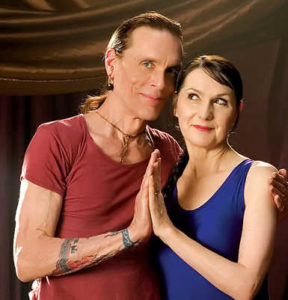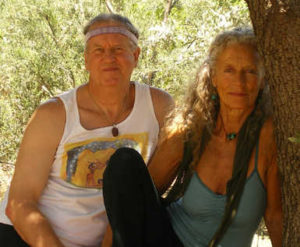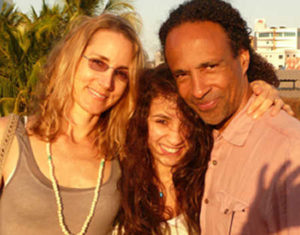relationship as teacher; teaching in relationship
“Hatha Yoga means the joining of sun and moon, masculine and feminine, and when we teach together it encourages this meeting inside each of the practitioners,” says David Life, who has been teaching for decades with his partner, Sharon Gannon.
David and Sharon are two of many notable examples of couples who not only share the same profession of teaching yoga, but often share time in a studio together. In an exploration of teaching and the lifelong, multifaceted path of a teacher, LA YOGA spent some time investigating the dynamics of teaching with and learning from a partner in love and on the mat. In this story, I talked to David Life and Sharon Gannon of Jivamukti Yoga; Angela Farmer and Victor Van Kooten; Los Angeles-based Iyengar Yoga teachers Marla Apt and Paul Cabanis; Ganga White and Tracey Rich who run the White Lotus Foundation; Bay Area-based Scott Blossom
Like any couple, in any relationship, there are joys and challenges, opportunities to teach and to learn. Many times working with a relationship coach can make an impact beyond what you might do alone. When yoga is involved, these can feel accelerated, as is the case when everything in our lives is examined on the mat. To enter in to this relationship, no matter the context, they have to meet first.
Ganga White met his wife and teaching partner Tracey Rich when he was a guest speaker visiting Hawaii where Tracey was a resident wahine. As Ganga relates, it was “fate influenced by a full moon.” Chance, and professional contacts, also brought David Life and Sharon Gannon together when a band she was touring with played at the Life Café in New York City, owned by none other than David Life. These meetings can be explosive or inspire smoldering affection. A mere five days after they met, the late Thom Birch proposed to Beryl Bender Birch. On the other extreme, Victor van Kooten nursed an inner crush on Angela Farmer for over a decade.
While some of these couples were teachers before they met, and others evolved into teaching together, in any case, the partnership of process and practice can inform teaching and life. Through teaching together, Scott Blossom and Chandra Easton “learned more about how to be spontaneous and trusting with each other. It [teaching together] provides a great reflection and inspiration for our individual growth as teachers too.”
When two people in a partnership are both teachers, it heightens their learning process – a challenging yet transformative dynamic. Ganga and Tracey say they “never cease to be amazed by some of the insights and expressions of teaching our partner comes up with.” This exchange is one of the benefits of working together – or even working in the same field. Another is the fact that the partner understands their shared work. As Paul Cabanis notes, “I don’t have to constantly explain what I do.” His wife, Marla Apt adds, “We can counsel each other on questions that arise and can empathize with each other’s challenges.” It’s almost like signing up for a life-long teacher training course.
There are also drawbacks. Some sort of division between work and home life is a frequently cited need, particularly in these types of work/love relationships. Ganga comments, “We’ve had to learn how to keep boundaries between our private lives and our teaching lives. We’ve learned not to roll over in the morning and ask ‘Hey honey, did you pay the bills yet?'” Sarah and Ty Powers expressed similar sentiments. For years Ty would encourage Sarah to “get off email” at the end of the day, right when she was ready to start tackling her inbox.
When partners team-teach, it brings the different instructions emphasized by individual teachers to the fore. While Angela Farmer and Victor van Kooten are accomplished as individuals; for the two, sharing the studio took a willingness to experiment. Victor notes, “Finding a balance on stage was sometimes confusing for us and for the students. Students receive images and ideas from two different angles and have to make up their own minds.” Angela adds, “It certainly was not always easy. We each had our own approach and connection to with students. It could get ‘bumpy’, but by being together, we learned a lot about listening, stepping back, creating in harmony and above all, how to set our personal issues aside and truly be there for the students.”
The duality of masculine and feminine is another angle intrinsic to Angela and Victor’s style. They say, “We all have feminine and masculine polarities which are rather fuzzy in their borderlines. It is clear that men and women handle these polarities differently but by teaching with a partner they become more apparent, for when one speaks, the other has to listen. At this moment in our teaching we have come to deeper interest in the emotional lives of our students, in how to inspire them to love themselves and how to support their individual needs rather than helping them improve their asana (posture) performance.”This duality has been important in their own journey as teachers. They say they emphasize “the feminine principles of observing and listening to our real and ever-changing nature, moving away from the more masculine control issues of knowledge in service of getting things done.” Interestingly, Angela feels that her own practice and teaching unfolded when she realized that she had been following a patriarchal lineage for years, and took steps to nurture and bring forth the feminine, an idea to which Victor was fully committed.
My personal experience of Angela and Victor (who have been teaching in tandem for over 20 years) was that they seemed to lead classes as one being, seamlessly alternating instruction. Before they even taught together, when both were teachers in the Iyengar tradition, Angela notes that students who had experienced them separately, often remarked, “you seem like brother and sister” or “your teaching is so complimentary.” Eventually they struck out on their own rooted in their partnership.
In a different approach, Sharon and David, when I studied with them, began class shoulder-to-shoulder, their hands in anjali mudra (palms of the hands together in a Namaste gesture) before assuming their complementary roles. One served as instructor while the other roamed the massive hall, making adjustments; in the second hour, they switched roles. David feels that, “It is helpful for people to experience us together, sharing the space equally and collaborating in the total experience.”
Many couples evolve together into these roles, which was the case for Thom and Beryl Bender Birch. Thom Birch, a renowned runner, met Beryl Bender at a road race in the early 1980s before he was ever interested in yoga. Yet his foray into yoga practice deepened their teaching since he could be a spokesperson for runners, allowing the duo to reach an intense athletic demographic. According to Beryl, “Thom was the most elite athlete and the tightest person I’d ever worked with at that point. He was a great role model for all the injured runners that came to our classes back in the 80s and 90s. His status as a world-class runner and successful use of yoga as a form of physical therapy gave a lot of credibility to the Ashtanga system at the time, in the eyes of athletes.” They taught together after the release of her book, Power Yoga, and demand for her teaching surged.
Beryl describes their teaching together as being characterized by a phenomenon of “non-local communication,” which she likens to quantum physics. She reminisces, “We didn’t have to look at each other; it just flowed, like one energy. There was no physical connection, like basketball. We were always aware of who had the ball, like a sense of role far beyond the material world.”
The challenges faced by any couple are experienced by those teaching together. According to Geralyn Gendreau, editor of the anthology The Marriage of Sex and Spirit, “Human love relationships are one of the most fertile grounds for growth and transformation. Also fraught with difficulty, frustration and pain, they dramatize for us our projections, addictions and wounds. Yet conscious use of relationships can be a fast track to spiritual and psychological transformation.” Beryl relates a story of asking a Jain monk where she would find the hardest teacher. “I had no idea I would marry him!”
Beryl also touches on the emotions she encountered when facing what she termed the “wine, women and song” experience of bringing her younger husband into the world of beautiful yoginis. For Beryl teaching with her husband was the “fine art of keeping her ego in check.” She struggled with feeling that Thom didn’t express things as delicately, or as “yoga-like” as she would prefer, often causing her to back-pedal for both. “We could spend hours processing things after teaching. Arguing even. I couldn’t give up control. It was learning non-attachment.” They eventually stopped teaching together for many reasons – his pursuit of music for one – but also in part because she couldn’t figure out how to let go enough to let him be responsible for his actions.
Sarah and Ty Powers face a challenge often encountered by couples who work in the same industry when one is superficially more prominent. While the two work together, they’ve come across people quizzically asking Ty what he does. Sarah credits Ty as being her first student, her biggest champion and her most honest sounding board, not to mention his work behind the scenes to keep her busy public career teaching Yoga, Yin Yoga and Buddhism running smoothly. While Ty’s work with Sarah is full-time, he has worked additionally as a television executive and a meditation teacher who focuses on issues of diversity. Their partnership and working together enables them to be together year-round. It’s a trade-off of intimacy versus having two incomes.
The Powers’ built their relationship around what they labeled a mutual inner investigation. They describe yoga entering their lives as being like love at first sight: a “body-based practice that didn’t ignore the mind-training that we had been focusing on and that allowed us to physically calm down in order to be better able to watch the mind.” It’s an experience they incorporate in their teaching.
When the arrival of their daughter (Imani Jade, now a vibrant teenager living in Paris) made three, they were each committed to maintaining their practices, and modeling the lifestyle for Imani. Since they preferred to practice at different times of the day, they could tag team parenting time and sessions on the cushion or the mat. Even with this support, as a mother who “nursed every two hours for three years,” Sarah describes the extreme discipline necessary to maintain a regular practice: “No one is going to roll the mat out, light a candle, hand you a cup of tea and walk you to your mat. But she [Imani Jade] did sleep and during those times, even if it was only for 20 minutes, I made sure to practice. And oftentimes it meant not cleaning the house or checking email.” With two role models, Imani was drawn to practice. As Ty relates, “She looked at it as quiet time with mommy in the morning when she was little.”With a partner, or a family, the relationship is also the teacher, and the spiritual path, and everyone is constantly switching roles. In this service, people note that they must remember the calling that is larger than the day to day struggle that may arise. “Our most important practice is kindness.
Extending kindness to the person closest to us is much more difficult than extending kindness to someone far away,” states David. “We are both committed to a goal…something which is beyond either one of us as separate entities.” Spiritual transformation is integral to Scott and Chandra’s partnership and their view of their commitment to teaching and to each other. “We’ve both been blessed with great teachers that have helped us to see through the surface issues to the depth of shared spiritual values. Our sense of commitment (and humor) is deeper than romance or worldly success. The lessons that we have drawn from our personal practice have given us patience and confidence in the process of growth, intimacy and wisdom.”
In a fitting assessment of the process of learning from our relationships, Victor summarizes, “We relate to ourselves, connecting with our own innate internal wisdom and sometimes a relationship can pull you away from yourself, becoming a hindrance and a challenge…or turn out to be a sailing ship that carries you smoothly into paradise. But one thing is sure: a relationship will have a deep influence on one’s life and can make you co-dependent. Once you have made the yogic connection with the many other parts of your being and are not dependent on a relationship, with or without marriage, you will have the possibility to create a co-independent relationship, work together and be together in a detached and loving way, celebrating each other’s different gifts.”
According to Ganga, “One of the greatest secrets to making anything and everything work is staying present in the moment. Mutual respect and appreciation never hurt as a starting point in relationship. A relationship is only as strong as your ability to handle, solve and not get overwhelmed by problems.”
Beryl’s closing comment, “Nothing can be all negative,” resonated with me as an especially practical way to approach relationship. There always will be ups and downs, but impermanence remains and all experiences provide us the opportunity to be better students – and therefore better teachers.
Amy Wong braved winter storms, even installing and removing chains in the Siskiyou Mountains, in service of this story, which she has dedicated to the memory of Thom Birch (1954-2006).
Thanks to the teachers who agreed to be interviewed for this story: Beryl Bender Birch (power-yoga.com), Sharon Gannon and David Life (jivamuktiyoga.com), Ganga White and Tracey Rich (whitelotus.org), Angela Farmer and Victor van Kooten (angela-victor.com), Marla Apt and Paul Cabanis (yoganga.com), Scott Blossom and Chandra Easton (shunyatayoga.com) and Sarah and Ty Powers (sarahpowers.com).




